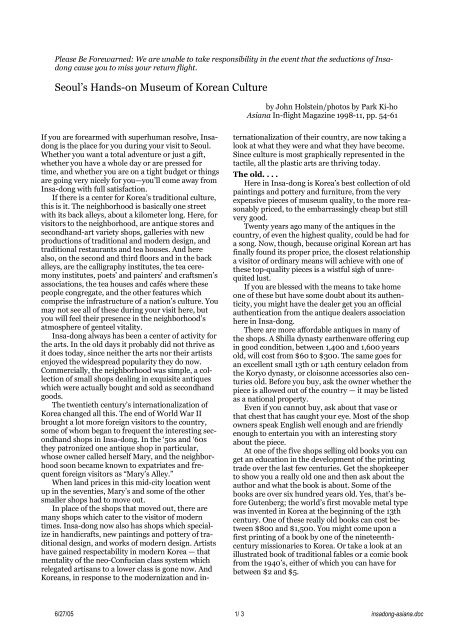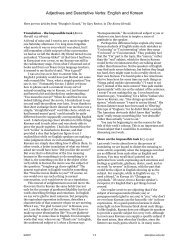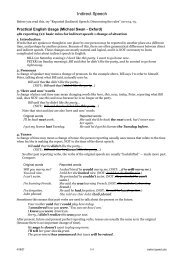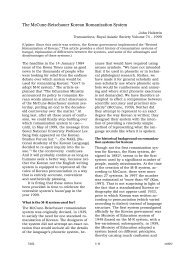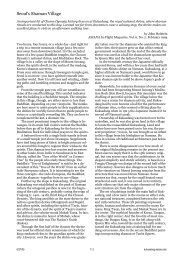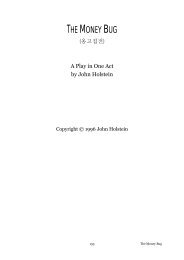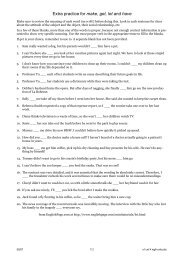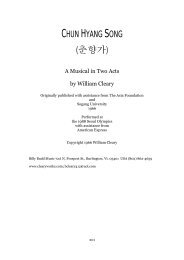Seoul's Hands-on Museum of Korean Culture - Korea Mosaic
Seoul's Hands-on Museum of Korean Culture - Korea Mosaic
Seoul's Hands-on Museum of Korean Culture - Korea Mosaic
You also want an ePaper? Increase the reach of your titles
YUMPU automatically turns print PDFs into web optimized ePapers that Google loves.
Please Be Forewarned: We are unable to take resp<strong>on</strong>sibility in the event that the seducti<strong>on</strong>s <strong>of</strong> Insad<strong>on</strong>g<br />
cause you to miss your return flight.<br />
Seoul’s <str<strong>on</strong>g>Hands</str<strong>on</strong>g>-<strong>on</strong> <strong>Museum</strong> <strong>of</strong> <strong><strong>Korea</strong>n</strong> <strong>Culture</strong><br />
by John Holstein/photos by Park Ki-ho<br />
Asiana In-flight Magazine 1998-11, pp. 54-61<br />
If you are forearmed with superhuman resolve, Insad<strong>on</strong>g<br />
is the place for you during your visit to Seoul.<br />
Whether you want a total adventure or just a gift,<br />
whether you have a whole day or are pressed for<br />
time, and whether you are <strong>on</strong> a tight budget or things<br />
are going very nicely for you—you’ll come away from<br />
Insa-d<strong>on</strong>g with full satisfacti<strong>on</strong>.<br />
If there is a center for <strong>Korea</strong>’s traditi<strong>on</strong>al culture,<br />
this is it. The neighborhood is basically <strong>on</strong>e street<br />
with its back alleys, about a kilometer l<strong>on</strong>g. Here, for<br />
visitors to the neighborhood, are antique stores and<br />
sec<strong>on</strong>dhand-art variety shops, galleries with new<br />
producti<strong>on</strong>s <strong>of</strong> traditi<strong>on</strong>al and modern design, and<br />
traditi<strong>on</strong>al restaurants and tea houses. And here<br />
also, <strong>on</strong> the sec<strong>on</strong>d and third floors and in the back<br />
alleys, are the calligraphy institutes, the tea cerem<strong>on</strong>y<br />
institutes, poets’ and painters’ and craftsmen’s<br />
associati<strong>on</strong>s, the tea houses and cafés where these<br />
people c<strong>on</strong>gregate, and the other features which<br />
comprise the infrastructure <strong>of</strong> a nati<strong>on</strong>’s culture. You<br />
may not see all <strong>of</strong> these during your visit here, but<br />
you will feel their presence in the neighborhood’s<br />
atmosphere <strong>of</strong> genteel vitality.<br />
Insa-d<strong>on</strong>g always has been a center <strong>of</strong> activity for<br />
the arts. In the old days it probably did not thrive as<br />
it does today, since neither the arts nor their artists<br />
enjoyed the widespread popularity they do now.<br />
Commercially, the neighborhood was simple, a collecti<strong>on</strong><br />
<strong>of</strong> small shops dealing in exquisite antiques<br />
which were actually bought and sold as sec<strong>on</strong>dhand<br />
goods.<br />
The twentieth century’s internati<strong>on</strong>alizati<strong>on</strong> <strong>of</strong><br />
<strong>Korea</strong> changed all this. The end <strong>of</strong> World War II<br />
brought a lot more foreign visitors to the country,<br />
some <strong>of</strong> whom began to frequent the interesting sec<strong>on</strong>dhand<br />
shops in Insa-d<strong>on</strong>g. In the ‘50s and ‘60s<br />
they patr<strong>on</strong>ized <strong>on</strong>e antique shop in particular,<br />
whose owner called herself Mary, and the neighborhood<br />
so<strong>on</strong> became known to expatriates and frequent<br />
foreign visitors as “Mary’s Alley.”<br />
When land prices in this mid-city locati<strong>on</strong> went<br />
up in the seventies, Mary’s and some <strong>of</strong> the other<br />
smaller shops had to move out.<br />
In place <strong>of</strong> the shops that moved out, there are<br />
many shops which cater to the visitor <strong>of</strong> modern<br />
times. Insa-d<strong>on</strong>g now also has shops which specialize<br />
in handicrafts, new paintings and pottery <strong>of</strong> traditi<strong>on</strong>al<br />
design, and works <strong>of</strong> modern design. Artists<br />
have gained respectability in modern <strong>Korea</strong> — that<br />
mentality <strong>of</strong> the neo-C<strong>on</strong>fucian class system which<br />
relegated artisans to a lower class is g<strong>on</strong>e now. And<br />
<strong><strong>Korea</strong>n</strong>s, in resp<strong>on</strong>se to the modernizati<strong>on</strong> and internati<strong>on</strong>alizati<strong>on</strong><br />
<strong>of</strong> their country, are now taking a<br />
look at what they were and what they have become.<br />
Since culture is most graphically represented in the<br />
tactile, all the plastic arts are thriving today.<br />
The old. . . .<br />
Here in Insa-d<strong>on</strong>g is <strong>Korea</strong>’s best collecti<strong>on</strong> <strong>of</strong> old<br />
paintings and pottery and furniture, from the very<br />
expensive pieces <strong>of</strong> museum quality, to the more reas<strong>on</strong>ably<br />
priced, to the embarrassingly cheap but still<br />
very good.<br />
Twenty years ago many <strong>of</strong> the antiques in the<br />
country, <strong>of</strong> even the highest quality, could be had for<br />
a s<strong>on</strong>g. Now, though, because original <strong><strong>Korea</strong>n</strong> art has<br />
finally found its proper price, the closest relati<strong>on</strong>ship<br />
a visitor <strong>of</strong> ordinary means will achieve with <strong>on</strong>e <strong>of</strong><br />
these top-quality pieces is a wistful sigh <strong>of</strong> unrequited<br />
lust.<br />
If you are blessed with the means to take home<br />
<strong>on</strong>e <strong>of</strong> these but have some doubt about its authenticity,<br />
you might have the dealer get you an <strong>of</strong>ficial<br />
authenticati<strong>on</strong> from the antique dealers associati<strong>on</strong><br />
here in Insa-d<strong>on</strong>g.<br />
There are more affordable antiques in many <strong>of</strong><br />
the shops. A Shilla dynasty earthenware <strong>of</strong>fering cup<br />
in good c<strong>on</strong>diti<strong>on</strong>, between 1,400 and 1,600 years<br />
old, will cost from $60 to $300. The same goes for<br />
an excellent small 13th or 14th century celad<strong>on</strong> from<br />
the Koryo dynasty, or clois<strong>on</strong>ne accessories also centuries<br />
old. Before you buy, ask the owner whether the<br />
piece is allowed out <strong>of</strong> the country — it may be listed<br />
as a nati<strong>on</strong>al property.<br />
Even if you cannot buy, ask about that vase or<br />
that chest that has caught your eye. Most <strong>of</strong> the shop<br />
owners speak English well enough and are friendly<br />
enough to entertain you with an interesting story<br />
about the piece.<br />
At <strong>on</strong>e <strong>of</strong> the five shops selling old books you can<br />
get an educati<strong>on</strong> in the development <strong>of</strong> the printing<br />
trade over the last few centuries. Get the shopkeeper<br />
to show you a really old <strong>on</strong>e and then ask about the<br />
author and what the book is about. Some <strong>of</strong> the<br />
books are over six hundred years old. Yes, that’s before<br />
Gutenberg; the world’s first movable metal type<br />
was invented in <strong>Korea</strong> at the beginning <strong>of</strong> the 13th<br />
century. One <strong>of</strong> these really old books can cost between<br />
$800 and $1,500. You might come up<strong>on</strong> a<br />
first printing <strong>of</strong> a book by <strong>on</strong>e <strong>of</strong> the nineteenthcentury<br />
missi<strong>on</strong>aries to <strong>Korea</strong>. Or take a look at an<br />
illustrated book <strong>of</strong> traditi<strong>on</strong>al fables or a comic book<br />
from the 1940’s, either <strong>of</strong> which you can have for<br />
between $2 and $5.<br />
6/27/05 1/ 3 insad<strong>on</strong>g-asiana.doc
The shops where you might have the most fun are<br />
the sec<strong>on</strong>dhand-art varieties from the old days. Feast<br />
your eyes <strong>on</strong> very good and very bad old and new<br />
ceramics, Koryo dynasty br<strong>on</strong>ze spo<strong>on</strong>s, gilt wood<br />
Bhuddas, s<strong>on</strong>orous bell-brass bowls, a rusty turn-<strong>of</strong>the-century<br />
Japanese can opener. . . a set <strong>of</strong> deer antlers<br />
These shops are a cornucopia clutter <strong>of</strong> days<br />
g<strong>on</strong>e by.<br />
. . . and the new<br />
Insa-d<strong>on</strong>g also has galleries which sell new paintings<br />
with both traditi<strong>on</strong>al and modern motifs. Buy or<br />
d<strong>on</strong>’t buy, but be sure to enjoy — many <strong>of</strong> these galleries<br />
boast <strong>of</strong> having gotten at least <strong>on</strong>e currently<br />
renowned artist started <strong>on</strong> his road to glory, and they<br />
may give you a good story or two about their progenies<br />
to take back with you.<br />
The exhibiti<strong>on</strong> posters they are producing these<br />
days are state-<strong>of</strong>-the-art in both design and printing.<br />
You might ask the owner or the artist being exhibited<br />
if you could have <strong>on</strong>e or two. These invariably<br />
friendly people will oblige you if they can. Then take<br />
it down the street and have it framed.<br />
One <strong>of</strong> the galleries is a 17th-century aristocrat’s<br />
house. Its <strong>on</strong>ly modificati<strong>on</strong> is the white display matting<br />
<strong>on</strong> the wall, and a set <strong>of</strong> s<strong>of</strong>a and chairs for<br />
guests to sit and have a chat with the artist or <strong>on</strong>e <strong>of</strong><br />
the interesting visitors who drop by from time to<br />
time. Ch<strong>on</strong> Kang-ho, who taught himself in his art,<br />
explains in English how he used epoxy and oils to<br />
fashi<strong>on</strong> his works <strong>on</strong> exhibiti<strong>on</strong> today. As he shows<br />
us around, a few students chat quietly over a cup <strong>of</strong><br />
green tea <strong>on</strong> the veranda, which opens <strong>on</strong>to the<br />
bamboo garden in back.<br />
In the pottery shops which sell new pieces is a<br />
fascinating range <strong>of</strong> traditi<strong>on</strong>al and modern designs,<br />
and even a few attempts at a synthesis <strong>of</strong> traditi<strong>on</strong>al<br />
and modern. Some <strong>of</strong> these shops have their own<br />
kilns in the provinces. One small shop specializing in<br />
tea and wine sets is run by a very nice old gentleman<br />
more than willing to impart lots <strong>of</strong> interesting details<br />
and anecdotes about how his pottery is produced.<br />
Even the household goods sold in Insa-d<strong>on</strong>g are<br />
art in themselves. In the furniture shops wardrobes<br />
and vanities shimmer with the luster <strong>of</strong> mother-<strong>of</strong>pearl<br />
emanating from under several carefully applied<br />
layers <strong>of</strong> lacquer. In the bedding shops are the silkcovered<br />
yo sleeping mats and the ibul quilts, in a<br />
festive rainbow pattern <strong>of</strong> dazzling reds, blues,<br />
greens and yellows, floral patterns <strong>of</strong> pale pastel embroideries,<br />
or print patterns in subdued or bold earth<br />
colors. In these shops you can also pick up a cushi<strong>on</strong><br />
cover in silk or cott<strong>on</strong> or hemp cloth, or have them<br />
do up a bedspread for you.<br />
How about a cheap, garish souvenir Sorry, you’ll<br />
have to look elsewhere. Instead, Insa-d<strong>on</strong>g handcraft<br />
shops <strong>of</strong>fer gifts you will later be sorely tempted to<br />
keep for yourself. Silk scarves, place mats woven<br />
from thick yarn <strong>of</strong> hemp or cott<strong>on</strong>, lacquered paper<br />
boxes for accessories and odds and ends, mulberrypaper<br />
lampshades, lacquered jewelry boxes with<br />
mother-<strong>of</strong>-pearl inlay, hand print or woodblock print<br />
general purpose greeting cards, crystal glasses, clay<br />
and wood figurines.<br />
In many smaller shops are new paintings and<br />
pottery with traditi<strong>on</strong>al motifs from all <strong>of</strong> <strong>Korea</strong>’s<br />
dynastic periods. These are crafted by younger artists,<br />
so the prices are outrageously reas<strong>on</strong>able. Many<br />
<strong>of</strong> these pieces are sublime, most are very good, and<br />
some, well. . . Every expatriate will have his story<br />
about that beauty he gave to a friend and will go to<br />
his grave kicking himself for it. Pick out a nice vase<br />
and ask the shopkeeper to make a lamp stand out <strong>of</strong><br />
it, for just a small extra charge.<br />
Even the really cheap pottery <strong>on</strong> the street carts,<br />
priced between $2 and $10, can be very good. And<br />
even something not so good can be used back home<br />
in a novel way, maybe as an exotic umbrella stand or<br />
waste c<strong>on</strong>tainer.<br />
And then there are the calligraphy shops with<br />
their fascinating brushes. Take home an ordinary<br />
eight-inch brush with bristles <strong>of</strong> horsehair, or <strong>on</strong>e <strong>of</strong><br />
goat, weasel, or ox hair. The handles <strong>on</strong> these<br />
brushes are <strong>of</strong> natural-finish bamboo, lacquer inlaid<br />
with a dusting <strong>of</strong> mother-<strong>of</strong>-pearl, or painted ox<br />
horn. You can even see a brush three feet l<strong>on</strong>g, which<br />
the artist holds like a mop as he walks across the paper<br />
he’s writing <strong>on</strong>. Keep a lookout here (and in the<br />
scroll-hanging shops) for simple unframed paintings<br />
in traditi<strong>on</strong>al motifs, d<strong>on</strong>e by struggling younger artists;<br />
you might happen <strong>on</strong> a really good <strong>on</strong>e which<br />
you can take home for under ten dollars.<br />
The traditi<strong>on</strong>al mulberry-bark papers sold in the<br />
paper shops come in a variety <strong>of</strong> whites and rich pastels,<br />
some with inlaid patterns <strong>of</strong> leaf specks or seaweed<br />
swirls or other <strong>of</strong> nature’s gifts. For centuries<br />
the whites have been applied <strong>on</strong> bamboo ribs to<br />
make the traditi<strong>on</strong>al fans, globe lanterns, and kites<br />
you can see in these shops even today. These warm<br />
whites can also serve as a very pleasant wall paper;<br />
enhance your gifts by wrapping them in the elegant<br />
pastels. And now they are finally producing c<strong>on</strong>temporary<br />
assortments <strong>of</strong> stati<strong>on</strong>ery and envelopes in<br />
the entire range <strong>of</strong> colors and patterns.<br />
Any self-respecting letter <strong>on</strong> the traditi<strong>on</strong>al stati<strong>on</strong>ery<br />
requires a pers<strong>on</strong>al seal. One shop displays<br />
an intricately carved antique seal a meter square, but<br />
you d<strong>on</strong>’t have to go that far. Tell the shopkeeper<br />
your kid’s name, or anything you would like translated<br />
into Chinese or <strong><strong>Korea</strong>n</strong> characters, and he’ll<br />
have a seal with a handle <strong>of</strong> agate, crystal, b<strong>on</strong>e, or<br />
wood ready for you in no time. D<strong>on</strong>’t forget a case <strong>of</strong><br />
the gooey red ink!<br />
No other neighborhood in Seoul comes close to<br />
lnsa-d<strong>on</strong>g’s <strong>of</strong>fering <strong>of</strong> quality traditi<strong>on</strong>al foods. You<br />
might want to start your day here with <strong>on</strong>e type <strong>of</strong><br />
meal, look around awhile, take a break at a traditi<strong>on</strong>al<br />
tea house, look around a bit more, take another<br />
rest at the traditi<strong>on</strong>al c<strong>on</strong>fecti<strong>on</strong>er’s shop, and<br />
then, after looking around some more, finish <strong>of</strong>f your<br />
adventure with another kind <strong>of</strong> meal.<br />
There are three major vegetarian restaurants in<br />
the neighborhood. All <strong>of</strong> them <strong>of</strong>fer their own versi<strong>on</strong>s<br />
<strong>of</strong> traditi<strong>on</strong>al decor, and all provide a plethora<br />
<strong>of</strong> side dishes, each <strong>on</strong>e prepared with special care,<br />
that you will not be able to do justice to. At San-kol<br />
and Bu-il you can get a thoroughly satisfying meal<br />
for around five dollars.<br />
San-ch’<strong>on</strong>’s owner, a former Buddhist m<strong>on</strong>k,<br />
brought some vegetarian delights with him from his<br />
mountain temple. Did he also bring the mellow, rich-<br />
6/27/05 2/ 3 insad<strong>on</strong>g-asiana.doc
odied, just heavenly native rice brew they serve<br />
here This is a good place to end the day, because in<br />
the courtyard at 8:00 every night a stage show is put<br />
<strong>on</strong> by renowned performers <strong>of</strong> the traditi<strong>on</strong>al arts.<br />
The elaborate standard meal and the entertainment<br />
will cost you <strong>on</strong>ly $20. Naturally, this place is very<br />
popular, so you will probably need to reserve a table.<br />
Other restaurants with their own special cuisine<br />
and atmosphere are listed <strong>on</strong> the map. One that expatriates<br />
like very much is Cho-um, where you can<br />
get top-pap, a simple meal <strong>of</strong> rice covered with a<br />
shrimp or meat sauce. And Yang-bin Garden <strong>of</strong>fers<br />
succulent barbecued ribs in a traditi<strong>on</strong>al decor.<br />
Man does not live by barbecued ribs al<strong>on</strong>e, so you<br />
will have to visit <strong>on</strong>e <strong>of</strong> Insa-d<strong>on</strong>g’s traditi<strong>on</strong>al tea<br />
houses. One tea house, which caters to younger visitors<br />
looking for the atmosphere c<strong>on</strong>venti<strong>on</strong>ally accepted<br />
as authentically <strong><strong>Korea</strong>n</strong>, is in the old tilero<strong>of</strong>ed<br />
house <strong>on</strong> the same 17th-century compound as<br />
the Ky<strong>on</strong>g-in Gallery.<br />
Here you can expect to hear the haunting strings<br />
<strong>of</strong> the classical kayagum, or the throaty voice <strong>of</strong> the<br />
taegum.<br />
Another tea house, <strong>on</strong> an upper floor <strong>of</strong> a 20thcentury<br />
building, expresses a traditi<strong>on</strong> peculiar to<br />
Insa-d<strong>on</strong>g. The atmosphere here was not planned —<br />
it has evolved naturally over the last hundred years<br />
around a clientele <strong>of</strong> the neighborhood’s denizens.<br />
Guests do not sit <strong>on</strong> silk cushi<strong>on</strong>s <strong>on</strong> a polished <strong>on</strong>dol<br />
floor at elegant lacquered tables, but in lumpycushi<strong>on</strong>ed<br />
1950s chairs at wobbly 1960s tables. The<br />
regulars’ poems are not enshrined in calligraphy <strong>on</strong><br />
hanging scrolls, they are scrawled <strong>on</strong> sheets <strong>of</strong> notebook<br />
paper scotch-taped to the wall. Here you will<br />
<strong>of</strong>ten hear the Far East’s popular music from the<br />
early 20th century, which reminds some Westerners<br />
<strong>of</strong> the blues.<br />
At the Ch<strong>on</strong>gno end <strong>of</strong> Insa-d<strong>on</strong>g is Pagoda Park,<br />
former site <strong>of</strong> the 15thcentury W<strong>on</strong>-gak Temple. The<br />
temple is g<strong>on</strong>e, but its spirit remains in the stumps <strong>of</strong><br />
sculptured marble railing supports lying here and<br />
there and the magnificent marble pagoda with its<br />
exquisite carvings. On the benches sit the country’s<br />
elders rehashing the glory and the tragedy <strong>of</strong> the illfated<br />
1919 independence movement, launched from<br />
the pavili<strong>on</strong> in the center <strong>of</strong> this park. And here are<br />
modern Seoul’s working people taking a break and<br />
Seoul’s pige<strong>on</strong>s, gray and brazen as anywhere. What<br />
is it about this simple people’s park that is so much<br />
more rewarding than the fancy palace parks<br />
A couple blocks to the west and parallel to Insad<strong>on</strong>g<br />
runs a six-lane artery from My<strong>on</strong>g-d<strong>on</strong>g and<br />
the Lotte Hotel. Shops selling paper and calligraphy<br />
materials are <strong>on</strong> the east side <strong>of</strong> the street. Across the<br />
street is a row <strong>of</strong> shops selling Buddhist materials:<br />
artifacts, books, cassette tapes <strong>of</strong> sutra chants, clothing,<br />
temple bells, prayer beads. . . And in back <strong>of</strong><br />
these shops is Chogye-sa, main temple for the country’s<br />
largest Zen Buddhist sect.<br />
For <strong>on</strong>e last stop, walk north to the Anguk-d<strong>on</strong>g<br />
intersecti<strong>on</strong> and turn left (west) <strong>on</strong> the other main<br />
street there. In the first block, <strong>on</strong> the south side <strong>of</strong><br />
the street, you will see a small shop which deals in<br />
pers<strong>on</strong>al accessories from countries all over the<br />
world except the industrialized West. The owner<br />
here takes resp<strong>on</strong>sibility: You are not required to tell<br />
your friends back home that you didn’t actually visit<br />
these countries.<br />
My special thanks to Jim Cunningham, <strong>of</strong> Hankuk<br />
University <strong>of</strong> Foreign Studies, for his imaginative<br />
suggesti<strong>on</strong>s and his instructi<strong>on</strong> in the history and<br />
arts <strong>of</strong> Insa-d<strong>on</strong>g.<br />
6/27/05 3/ 3 insad<strong>on</strong>g-asiana.doc


